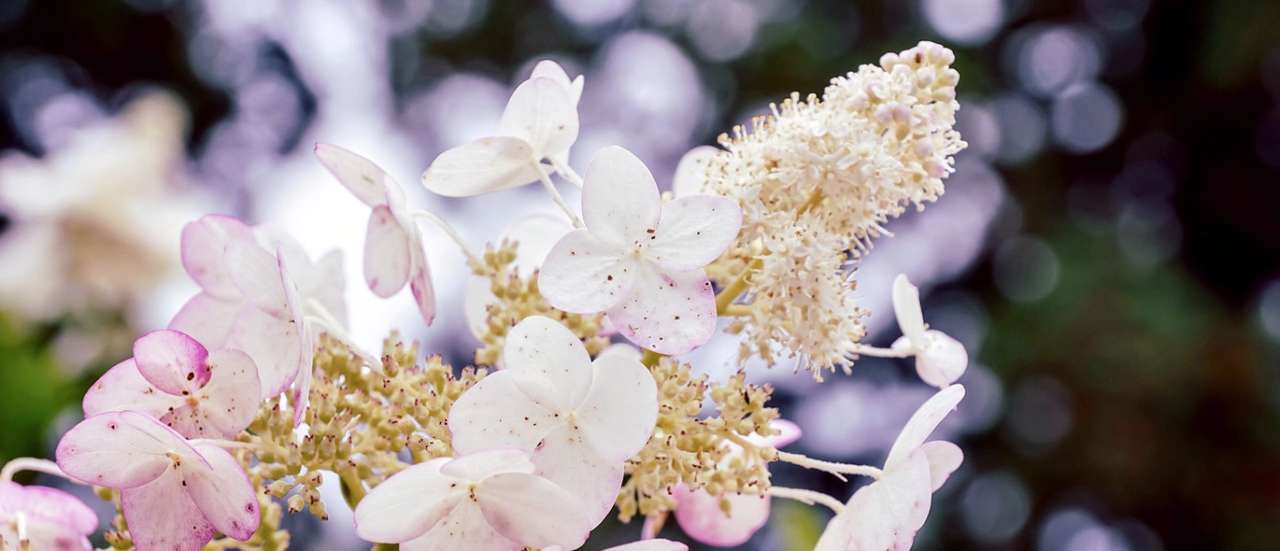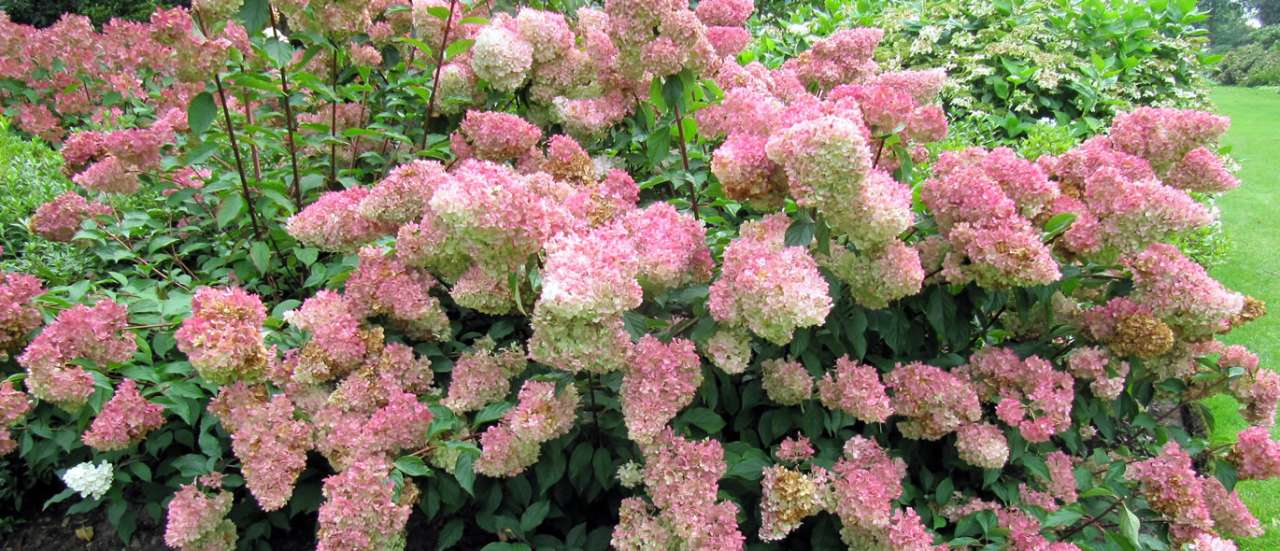Hydrangeas are a popular hardy shrub that come with a range of growth habits. Some are compact, others can grow into huge forms and there's even climbing varieties. The flower heads can be conical, flat or produce huge globes. The most recognisable varieties are mop-head or lacecap and they come in various shades of blue, red and white, with some even changing colour depending on the ph levels of your soil. Most are ideal for a part of the garden that remains in partial shade and many will flower from summer, right into autumn. Growing hydrangeas is easy and with such a range of varieties, there's sure to be one suitable for any space, so here are a few tips on how you can add one of these wonderful shrubs to your garden:
 Hydrangea 'Confetti' - Image courtesy of Pixabay
Hydrangea 'Confetti' - Image courtesy of Pixabay
When and Where to plant hydrangeas:
As with many shrubs and perennials, spring and autumn are the best times to plant as the soil is usually warm and moist. These shrubs can be planted any time in the summer but you just have to ensure that the soil remains moist, which in our climate, isn't usually a problem.
They will do best in moist but well drained soil in dappled shade or partial shade and are best kept away from frost pockets or strong drying winds. Any soil type in terms of ph is fine, but as we've already mentioned, some varieties will retain their strong colour or change colour depending on the acidity or alkaline levels in the soil. In general, blue hydrangeas will remain blue in acidic soils or ericaceous compost and pink/red hydrangeas will retain colour in alkaline soils. If they are planted in the opposite type of soil they will start to change colour and will generally come out in various shades of purple depending on the soil balance.
How to plant hydrangeas:
As hydrangeas like moist soil, if you have a light soil in your garden it is best bulked up with some organic matter such as well-rotted farm-yard manure.
Before removing the plant from it's pot, give the root ball a good soak by giving it a good watering an hour or so before planting.
Dig a hole, larger than the width of the pot but never plant the hydrangea deeper than its original pot. This is the same rule for shrubs in general. To be sure, you can put the plant, pot and all, into the hole you have dug and just place a stick across the hole to ensure that the top of the pot is level or slightly proud of the surrounding soil. Once you are happy remove the plant from its pot and check the roots. You may have to gently tease some of the roots apart if they are starting to wind around themselves too much i.e. they have become 'pot bound'.
Place your hydrangea in the hole, again ensuring that it is no deeper than it was in the original pot and then backfill the hole. Firm in and then give the plant a good mulch with leaf-mould, compost or well-rotted manure, being sure to keep the mulch an inch or so away from the plant stem to avoid any rot. Water well and ensure the soil is kept fairly moist (not waterlogged) through its first spring and summer.
If you are planting a climbing hydrangea it is best to train them initially using wire or some sort of support to get them started, after which they will make their own way due to self-clinging roots.
 Hydrangea 'Vanilla Fraise' - Photo by Leonora (Ellie) Enking (CC BY-SA 2.0)
Hydrangea 'Vanilla Fraise' - Photo by Leonora (Ellie) Enking (CC BY-SA 2.0)
Looking after your hydrangea:
Keep well watered through hot whether and if you have a blue variety and want to keep that rich colour, then you are best to water with rain water (most tap water leans towards the alkaline and can start to turn your hydrangeas towards the pink end of the spectrum)
You don't need to feed your hydrangeas as this tends to bring on a mass of foliage at the expense of flowers. A good mulch in the spring will suffice. This makes them pretty easy to maintain.
Pruning will depend on your variety as some generate flowers in new growth, some on old growth and some on both. Incorrect pruning is the most common reasons for people thinking that there is something wrong with their hydrangea as it is not flowering. The pruning regime for the different varieties is:
- Hydrangea macrophylla and Hydrangea serrata: This variety produces flowers on old wood. Pruning is best done in spring when often the old flower heads still remain as this gives an indication of where your new flowers will come from. Look for a set of plump buds just below the the dead flower head. This is where the new flowers will be produced, so cut just above that. If you want to thin the plant out a little, then you can cut some stems at the base.
- Hydrangea paniculata and Hydrangea aborescens: It is not essential to prune these at all. If left unpruned however you will end up with all the flowers sitting at the top of the plant as these varieties produce flowers on new growth. Again, spring is the best time for trimming these hydrangeas back and you can prune to your desired form, cutting any stem just above a pair of healthy buds.
- Hydrangea aspera and Hydrangea quercifolia: These are unfussy and could just do with a light prune and tidy up in spring, removing any old flower heads or crossing stems.
- Hydrangea petiolaris or climbing hydrangea: Simply cut back the the flowering shoots to a pair of new buds after flowering in summer.
Transplanting Hydrangeas
If you are looking to move a hydrangea, this is best done any time from late autumn to late winter, during the plant's dormant period. This is less likely to cause the plant stress (yep - plants get stressed too) and will also help with root establishment as the soil will contain more moisture.
Propagation
This is best done from stem cuttings taken in spring or early summer. Just take several cuttings of non-flowering stems, with each stem being around 10-15cm long, making the cut just believe a bud or leaf-node.
You can then strip back any leaves so that you only leave one pair of leaves near the top of the stem. The cuttings can then be placed around the edges of a pot filled with well draining compost. Just the top section of the stem cutting should remain above the soil. If the top leaves are particularly large, these can be cut in half to reduce moisture being lost through evaporation.
You then need to keep the soil moist but not waterlogged (you can place a polythene bag over the pot to retain moisture) and place the pot in a bright position away from direct sunlight.
After a few weeks roots should start to develop. You can check this by just looking at the underneath of the pot. If roots are starting to grow out of the bottom of the pot, you can begin dividing your cuttings and potting them on. You can then continue to pot on until your hydrangea plants have reached a size you are happy with for planting them in their final position.
Follow these tips and you will find that hydrangeas face very few problems, are pretty low-maintenance and will bring you joy year after year. We have a wide selection of hydrangeas available online and instore and if you have any questions about which hydrangea is best for your garden, our friendly, qualified staff are here to help.








